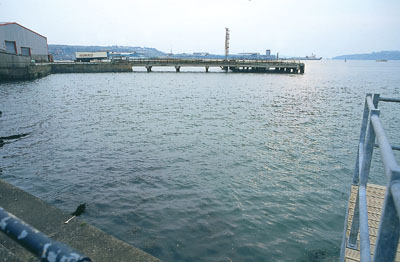 |
This pier mark offers some superb summer and winter fishing with literally anything possible from big bass to ray and conger eel, as well as the normal smaller species.
Just down river from the
A variety of fish can be caught here because they too move up and down the Cleddau river, that is very wide at this junction. Take the A477 driving through the roundabout directing you to the bridge and look for signs to the pier. There is parking on the pier and clean toilet facilities. A drop net is very useful if you manage to get stuck into something a little bigger. Fishing is always best after dark.
Mark One
On the left as you drive in is a shallow end with a muddy bottom, lined with weed-covered rocks. As the tide rises, mullet and the occasional school bass nose in around the weed. There’s a good opportunity to float fish harbour ragworm, prawn or even live sandeel here. In winter, whiting can be taken close in at high water, especially after dark. This is a good corner mark for unusual mini species to small hooks.
Mark Two
Further along the pier wall, where the launching gantry begins, the water deepens slightly, yet the bottom is reasonably clean, mixed ground. In autumn, after darkness, casting towards the next jetty will find codling here together with early whiting.
Crab is the favoured bait for codling, with fish baits preferred for whiting. There’s always the chance of a conger eel here, too. The first half of a small spring tide offers the best chance.
Mark Three
Moving further out to the front of the left-hand point of the pier, much deeper water is found and the flowing tide swings in at this position. The ground here can be very rough and rotten bottom rigs are advisable. Big conger are often taken to fish baits. Do not fish the bigger tides, as the current will result in big losses of tackle. In summer the pleasure-boat-launching gantry is in place, so it’s best to plan your landing spot in advance. Dogfish can be a nuisance. Fishing close to the pier wall with head and guts sometimes produces a good bass. Baited feathers take good whiting in winter.
Mark Four
To the right, just before the start of the slip, is the most popular mark with anglers. Casting various distances will produce different results. The bottom here varies considerably with rocky ledges creating different depths and snags. Best fished on the ebb of a low to mid-range spring. Good for thornback ray and conger in early autumn with a surprise of a good bass near the wall. In recent years smoothhound have made an appearance in early summer. On calm, frosty, late-autumn evenings herring can often be heard dimpling in the lights of the pier. Small shrimp feathers can take them.
Mark Five
The slip is also favoured by anglers, as the ground shallows near the end and casts can be made uptide on to a muddy bottom. Flatties are sometimes taken to worm baits with the occasional bass too.
Ray are hooked on fish or sandeel baits as they move out on the ebbing tide, so go prepared for some exciting sport if there’s a good run of ray. Codling, too, move out on the tide but prefer crab baits or lugworm and squid cocktails.
Mark Six
Inside the slip, towards the Kelpie boat stores, debris and waste collects in the corner.
The serious mullet angler, who is prepared to groundbait with mashed bread and fish, will find some decent mullet on the top of the tide. You’ll need a spinning rod and fixed spool reel loaded with 8lb to 10lb mono for this sport and if you’re lucky enough to get hooked up, try to keep the mullet from crash-diving into the snags.
Patience is a virtue!
Tackle Shops
A&E Boat Sales & Watersports Equipment 14b Pembroke Street, Pembroke Dock, Dyfed. Tel: 01646 622456
Pembroke Angling 31 Meyrick Street, Pembroke Dock, Dyfed. Tel: 01646 622712
TSF Top Tip 1
Vary your casting distances at mark five with a sandeel bait to search out the ray sport.
TSF Top Tip 2
A mackerel-head-and-guts bait fished close to the pier can often result in a big bass for those prepared to sit it out.





